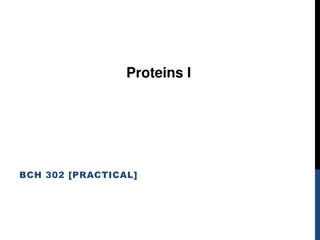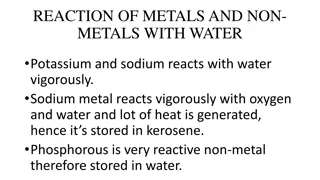C-Reactive Protein (CRP) Test: Uses and Principle
C-Reactive Protein (CRP) is a liver-produced protein that indicates inflammatory conditions. The CRP test helps detect infections, monitor diseases like cancer, and evaluate inflammatory conditions. The test principle involves latex agglutination for CRP detection in human serum.
Download Presentation

Please find below an Image/Link to download the presentation.
The content on the website is provided AS IS for your information and personal use only. It may not be sold, licensed, or shared on other websites without obtaining consent from the author.If you encounter any issues during the download, it is possible that the publisher has removed the file from their server.
You are allowed to download the files provided on this website for personal or commercial use, subject to the condition that they are used lawfully. All files are the property of their respective owners.
The content on the website is provided AS IS for your information and personal use only. It may not be sold, licensed, or shared on other websites without obtaining consent from the author.
E N D
Presentation Transcript
C-reactive protein (CRP) Prof. Dr. Baydaa H Abdullah
What is C-reactive protein (CRP)? C-reactive protein (CRP) is a special type of protein produced by the liver in response to inflammatory cytokines such as Interleukin-6 (IL-6). CRP is classified as an acute phase reactant, which means that its levels will rise within a few hours after tissue injury, the start of an infection, or other cause of inflammation. The most important role of CRP is its interaction with the complement system, which is one of the body s immunologic defense mechanisms
Why CRP test is done? C-reactive protein (CRP) test is performed to determine if a person has a problem linked to acute infection or inflammation. The CRP test is not diagnostic of any condition, but it can be used together with signs and symptoms and other tests to evaluate an individual for an acute or chronic inflammatory condition. These include:
To determine if there is infection after surgery: CRP levels normally increase within two to six hours following surgery but then return to normal by the third day; if CRP levels are elevated three days after surgery it means there is an infection. To keep track of an infection or disease that can cause inflammation: Inflammatory bowel disease (IBD), lymphoma ( cancer of the lymph nodes), immune system diseases such as lupus (SLE), rheumatoid arthritis ( swelling of the tissues that line the joints) and osteomyelitis (infection of the bone) are some conditions in which inflammation can be monitored with a CRP test. To monitor treatment of a disease such as cancer or infection: Not only do CRP levels go up quickly if you have an infection but they also return to normal quickly if you are responding to the treatment. An extremely elevated CRP is suggestive of a possible bacterial infection. Measures of CRP add to the diagnostic procedure in selected cases (e-g. in the differentiation between a bacterial and a viral infection).
CRP Test Principle CRP Test is based on the rapid latex agglutination method introduced by Singer, et. al., in 1957. This is a slide agglutination test for the qualitative and semiquantitative detection of C-Reactive Protein (CRP) in human serum. Latex particles coated with goat IgG anti-human CRP are agglutinated when mixed with samples containing CRP. When latex particles coated with human anti-CRP are mixed with a patient s serum containing C reactive proteins, this results in visible agglutination wihtin 2 minutes.
The test is based on the reaction between patient serum containing CRP as the antigen & the corresponding antibody coated to the treated surface of latex particle. The coated particles enhance the detection of an agglutinate reaction when antigen is present in the serum being tested.
CRP Test Procedure (Qualitative) Bring all reagents and serum sample to Room Temperature and mix latex reagent gently prior to use. Do not dilute the controls and serum. Place 1 drop each of serum, positive control and negative control on separate reaction circles. Then add CRP latex reagent 1 drop to each of the circles. Mix with separate mixing sticks and spread the fluid over the entire area of the cell. Tilt the slide back and forth slowly for 2 minutes observing preferably under artificial light.
CRP Test Procedure (Qualitative) Sera with positive results in the screening test should be retested in the semiquantitative test for obtaining the titre. Make serial two fold dilutions of the sample in 9 g/L saline solution. Proceed for each dilution as in the qualitative method.
Interpretation Agglutination of latex particles is considered a positive reaction, indicating the presence of C-reactive protein at a significant and detectable level. Specimens which do not contain human CRP will not cause agglutination. If controls do not give expected reactions the test is invalid and must be repeated. The titer, in semi-quantitative method, is defined as the highest dilution showing a positive result.
NOTE The reference range for C-reactive protein is : CRP: 0-10mg/L High CRP concentration samples may give negative results .Re test the sample again using a drop of 20 l . The strength of agglutination is not indicative of the CRP concentration in the samples tested. Clinical diagnosis should not be made on findings of a single test result, but should integrate both clinical an laboratory data.
LIMITATIONS Reaction time is critical. If reaction time exceeds two minutes, drying of the reaction mixture may cause false positive results. Freezing the CRP Latex Reagent will result in spontaneous agglutination. phenomenon (antigen excess). It is recommended, therefore, to check all negative sera by retesting at a 1:10 dilution with Saline Solution.
Human chorionic gonadotropin (hCG) is a glycoprotein hormone secreted by the developing placenta. In a normal pregnancy, hCG can be detected as early as seven days following conception. At the time of the first missed menstrual period, hCG concentration is about 100 mIU/ml, reaching peak levels at the end of the first trimester. HCG is an excellent marker for early detection of pregnancy.
Latex Slide check is a rapid latex agglutination pregnancy test detecting hCG at levels 0.3 IU/ml and higher. The test utilizes monoclonal antibodies raised against hCG. The test is based upon the rapid agglutination of antibody coated latex particles. HCG molecules present in the urine specimen form complexes with the antibody coated latex particles and visible agglutination results
HCG (is hormone secreted in pregnancy that is made by the developing embryo soon after coception and later by part of the placenta) to maintain the fetal viability preventing the disintegration of the corpus luteum of the ovary and thereby maintaining progesterone production that is critical for a pregnancy in humans; it also affects the immune tolerance of the pregnancy. HCG is excreted in the urine of pregnant women. Detection of this hormone in urine or serum is an easy first method of diagnosis of pregnancy. The hormone can be detected as early as the sixth day after conception. HCG is also an important tumor marker because it is produced by some kinds of tumor, such as: seminoma, choriocarcinoma, germ cell tumors, hydatidiform mole formation, teratoma with elements of choriocarcinoma, and islet cell tumor
COMPONENTS OF THE TEST 1-Latex Reagent-Anti-hCG monoclonal antibody-coated latex particle suspension containing sodium azide, in a vial with a glass dropper. 2-Positive Control-HCG in a buffered protein solution, with sodium azide as preservative, in a dropper vial. 3-Dropper/Stirrers (100 pcs). 4-Glass slide (re-usable, one per kit).
COLLECTION OF SPECIMENS Collect the urine sample in a clean, dry container, either plastic or glass, without preservatives. Specimens may be collected at any time; however the first morning urine contains the highest concentration of hCG and therefore is preferable for earlier detection of pregnancy. Urine specimens may be refrigerated (2-8 C) and stored up to 72 hours prior to testing. If samples are refrigerated, equilibrate to room temperature before testing. Filter, centrifuge, or let settle urine samples exhibiting visible precipitates, use clear aliquots for testing.
TEST PROCEDURE 1-Place one drop of urine specimen into a circle on the slide 2-Shake the vial containing Latex Reagent to resuspend the suspension completely. Add one drop of suspension to the urine on the slide. 3-Stir with a Dropper/Stirrer until the mixture is spread over the entire surface of the circle. 4-Rock the slide gently during two minutes, providing circular movement of the liquid inside the circle. 5-Watch for agglutination at two minutes. A good light source may improve visibility of agglutination. Note: Do not interpret the test results after more than three minutes
INTERPRETATION OF RESULT Positive: at two minutes, agglutination is visible Negative: agglutination is not visible within two minutes.
EXPECTED VALUES Healthy men and healthy non-pregnant women do not have detectable levels of hCG. HCG levels of 0.3 IU/ml can be reached in pregnant women as early as a few days after a missed period. HCG levels peak about eight weeks after the last menstrual period and then decline to lower values for the remainder of the pregnancy. Levels usually return to normal within a few days after parturition
LIMITATIONS OF THE TEST Test urine specimens only. Latex Slidecheck is not intended for serum testing. Presence of hCG at 0.3 IU/ml or greater is required for a positive result. Concentrations of hCG below this level will give negative results. Elevated urine hCG levels comparable to those observed in early pregnancy may also be associated with trophoblastic or non-trophoblastic neoplasms such as a hydatidiform mole or choriocarcinoma; therefore such pathologic conditions should be ruled out before a positive diagnosis is reached. As with all diagnostic tests, a definitive clinical diagnosis should not be based on the results of a single test, but should be made only by the physician after all clinical and laboratory findings have been evaluated.
Pregnancy test strip Pregnancy detection kits containing a strip or card impregnated with anti-hCG globulin are readily available. The test is executed by immersing the proper end of the strip in urine or sprinkling three drops of urine on the indicated site of a card. The result is readable within two to three minutes. https://upload.wikimedia.org/wikipedia/commons/thumb/f/fe/Pregnancy_test_strip.jpg/220px-Pregnancy_test_strip.jpg
























